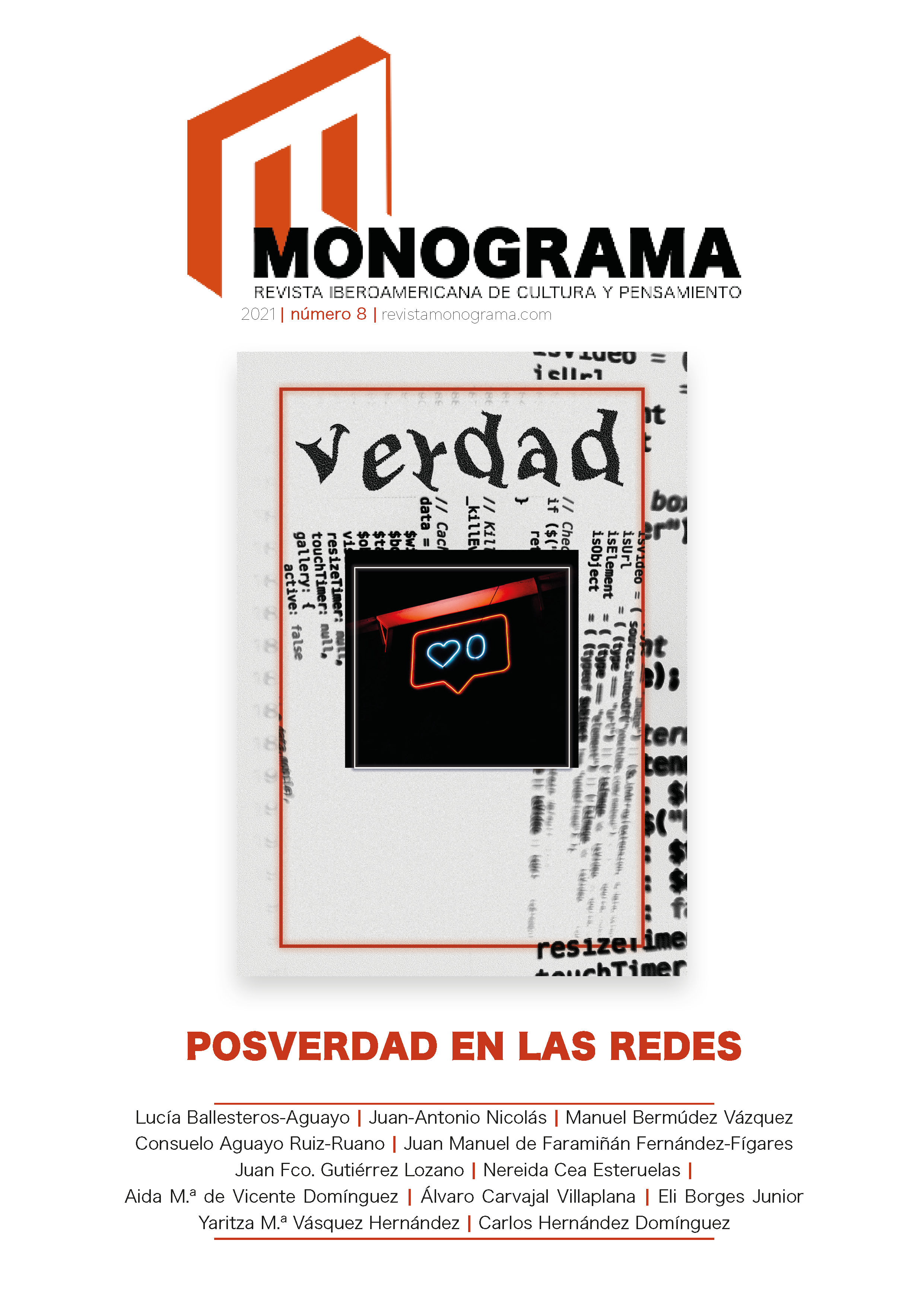Understanding as a Strategy against Disinformation
An Outline for a Communicative Hermeneutics in Professional Journalism
DOI:
https://doi.org/10.36008/monograma.2021.08.1810Keywords:
hermeneutics, communication, post-truth, disinformation, journalismAbstract
In the information society, the profusion of electronic devices, the speed of evolution towards new communicative forms and the convergence of transmedia narrative produce a revolution in media communication. Therefore, it is necessary to reorient decision-making in the design of quality journalistic practice. This paper is an attempt to develop an approach of the hermeneutics of understanding to the communicative reality through three essential elements in media communication: language, authority (including scientific authority and journalistic specialties) and context. The implementation of the hermeneutic method in Communication Sciences might well address an important approach. This fact involves the journalistic profession from a transdisciplinary and plurimethodological orientation. In addition to this, communication professionals provide discursive tools so as to address disinformation as a phenomenon derived from a broader problem installed in our society such as post-truth.
Downloads
References
ANDERSON, J. y MEYER, T. P. (1988). Mediated Communication. A Social Action Perspective. Londres: Sage.
CARRERA, P. (2018). «Estratagemas de la posverdad». Revista Latina de Comunicación Social, 73, pp. 1469-1482. Disponible en: http://www.revistalatinacs.org/073paper/1317/RLCS-paper1317.pdf [Consulta: 31 enero 2021]. doi: https://doi.org/fcnc.
CARRIÓN, J. (2021). «La posverdad y sus autopsias». The New York Times. 31 enero. Disponible en: https://www.nytimes.com/es/2021/01/31/espanol/opinion/fake-news-que-son.html [Consulta: 31 enero 2021].
BARBAS COSLADO, A. (2012). «Educomunicación: desarrollo, enfoques y desafíos en un mundo interconectado». Foro de Educación, 10 (14), pp. 157-175. Disponible en: https://www.forodeeducacion.com/ojs/index.php/fde/article/view/22 [Consulta: 31 enero 2021].
CHAPARRO-ESCUDERO, M., ESPINAR-MEDINA, L., EL-MOHAMMADIANE-TARBIFT, A. y PERALTA-GARCÍA, L. (2020). Guía de transición ecosocial y principios éticos para nuestros medios. Madrid: Fragua.
GADAMER, H. G. (1977). Verdad y método (trad. de A. Agud Aparicio y R. De Agapito), vol. I. Salamanca: Ediciones Sígueme.
GADAMER, H. G. (1998). El giro hermenéutico (trad. de A. Parada). Madrid: Cátedra.
GARCÍA VIVERO, G. y LÓPEZ GARCÍA, X. (2021). «La verificación de datos en Europa. Análisis de 5 iniciativas europeas: Maldita.es, Newtral, Pagella Politica, Les Décodeurs y BBC Reality Check». adComunica. Revista Científica de Estrategias, Tendencias e Innovación en Comunicación, 21, pp. 235-264. Disponible en: http://www.e-revistes.uji.es/index.php/adcomunica/article/view/5506/6290 [Consulta: 31 enero 2021]. doi: https://doi.org/fszs.
GÓMEZ MOMPART, J. Ll., GUTIÉRREZ LOZANO, J. F. y PALAU SAMPIO, D. (2013). La calidad periodística. Teorías, investigaciones y sugerencias profesionales. Barcelona, Castellón de la Plana, Valencia: UAB/UJI/UPF/UV, Col. Aldea Global.
GÓMEZ MOMPART, J. Ll., GUTIÉRREZ LOZANO, J. F. y PALAU SAMPIO, D. (2015). «La calidad periodística en España según la percepción de los periodistas». Estudios sobre el mensaje periodístico, 21(1), pp. 13-30. Disponible en: https://revistas.ucm.es/index.php/ESMP/article/view/50647/47047 [Consulta: 31 enero 2021]. doi: https://doi.org/fsxg.
MOSCÓN, P. (2017). «La crítica de los prejuicios en la Ilustración alemana y su recepción en la obra de Kant». Ideas y valores: Revista Colombiana de Filosofía, 66(165), pp. 147-170. Disponible en: https://revistas.unal.edu.co/index.php/idval/article/view/53434/pdf_7 [Consulta: 31 enero 2021].
ROMERO RODRÍGUEZ, L. M. (2014). Pragmática de la desinformación: estratagemas e incidencia de la calidad informativa de los medios [tesis doctoral, Universidad de Sevilla]. Disponible en: http://rabida.uhu.es/dspace/handle/10272/9605 [Consulta: 31 enero 2021].
MCQUAIL, D. (1991). Introducción a la teoría de comunicación de masas. Barcelona: Paidós.
NICOLÁS MARÍN, J. A. (2019). «Posverdadera: cartografía de un fenómeno complejo». Diálogo Filosófico, 105, pp. 302-340.
NOELLE-NEUMANN, E. (1983). «The effect of media on media effects research». Journal of Communication, 33(3), pp. 157-165.
PALMER, R. E. (2002). ¿Qué es la hermenéutica? Teoría de la interpretación en Scheiermacher, Dilthey, Heidegger y Gadamer (trad. de Beatriz Domínguez Parra). Madrid: Arco/Libros.
WATZLAWICK, P., BEAVIN, J. H. y JACKSON, D. D. (1974). Teoría de la comunicación humana. Interacciones, patologías y paradojas. Buenos Aires: Editorial Tiempo Contemporáneo.
Downloads
Published
How to Cite
Issue
Section
License
Copyright (c) 2021 Monograma. Revista Iberoamericana de Cultura y Pensamiento

This work is licensed under a Creative Commons Attribution-NonCommercial-NoDerivatives 4.0 International License.
Esta obra está bajo una licencia de Creative Commons Reconocimiento-NoComercial-SinObraDerivada 4.0 Internacional






